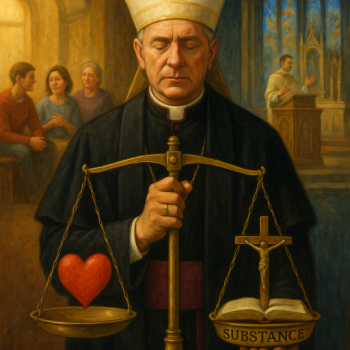 Guest writer: Pilgrim
Guest writer: Pilgrim
Introduction
The 2018 revision to Catechism of the Catholic Church §2267 by Pope Francis, declares the death penalty “inadmissible because it is an attack on the inviolability and dignity of the person,” and commits the Church to work “with determination for its abolition worldwide” [1]. This has stirred wide-ranging debate among Catholic theologians, clergy, and lay scholars. While some interpret this as a legitimate development of doctrine that deepens the Church’s pro-life witness, others view it as a rupture with Scripture, Tradition, and prior magisterial teaching. What lies at the heart of this debate is not simply the morality of capital punishment itself, but the meaning and implications of the term “inadmissible”. Unlike declaring an act intrinsically evil, which leaves no room for contextual application, inadmissible is theologically and pastorally open-ended. It invites interpretation, development, and reflection; qualities that can be both assets and liabilities in today’s polarized and soundbite-driven age.
This tension is not new. Since the Second Vatican Council, the Church has wrestled with how to balance fidelity to its doctrinal tradition with a pastoral openness to modern contexts. The growing divide between “progressives” and “traditionalists” has been marked by suspicion on both sides: of rigidity, on the one hand, and of doctrinal compromise, on the other. The debate over the death penalty is one expression of this wider fault line.
This essay explores the death penalty not simply as a moral question, but as a case study in how the Church articulates truth over time. It considers how a term like inadmissible can act as a bridge for doctrinal development and pastoral sensitivity, while also risking misinterpretation in an era marked by weakened ecclesial trust, social media fragmentation, and a widespread demand for moral clarity. It assesses whether Pope Francis’s revision constitutes a genuine development or an unintended doctrinal rupture and what this reveals about the broader challenges facing the Church in the 21st century.
Doctrinal Development: A Deeper Witness to Human Dignity
Proponents of Pope Francis’ revision argue that it reflects a valid and organic development of doctrine in line with John Henry Newman’s theory of doctrinal growth, entailing a deeper understanding of an unchanging truth, rather than a change in the truth itself. According to this view, while the Church previously tolerated the death penalty as a form of justice and societal protection, it now judges it to be no longer morally justifiable or necessary given the development of modern penal systems, the secularization of society, and a deepened understanding of and desire to protect human dignity. Viewed this way, it is a prudential adjustment to meet different circumstances, Cardinal Luis Ladaria, then-prefect of the Congregation for the Doctrine of the Faith, explained that the new formulation “expresses an authentic development of doctrine that is not in contradiction with the prior teachings of the Magisterium” [2].
This assertion finds support in the trajectory laid by Pope John Paul II in Evangelium Vitae (1995), which stated that cases in which the death penalty is necessary “are very rare, if not practically non-existent” [3]. The revised Catechism thus builds on an established prudential judgment and makes explicit what John Paul II had implied – the application of the death penalty in the modern world violates the dignity of the human person. The emphasis now given to mercy, redemption, and the sanctity of life, reflects a broader pastoral and theological shift within the Church in modern secular nation states to affirm life even in the face of grave crime.
Theologians such as E. Christian Brugger have long argued that the death penalty cannot be reconciled with a consistent ethic of life rooted in the Gospel [4]. He contends that capital punishment not only undermines the Church’s pro-life witness, but contradicts the redemptive model of justice exemplified by Christ. Seen through this lens, the revision, whilst not a complete rejection of previous teaching, would constitute a break in continuity to reflect a shift towards fulfilling the Church’s deep commitment to the Gospel. However, other proponents see it as a deeper understanding and a more explicit articulation of existing principles within contemporary society, not a rupture.
Supporters emphasize the authority of the Magisterium to develop moral teaching in new historical and social contexts just as it did over slavery and usury. Pope Francis has not declared the death penalty “intrinsically evil,” which would pose a doctrinal contradiction, but rather “inadmissible,” i.e., a judgment that accounts for historical development and current circumstances. Catholic philosopher Christopher Tollefsen interprets this move as a deepening of the Church’s understanding of the human person and the limits of state power over life [5].
The change was widely welcomed by many bishops’ conferences and Catholic human rights advocates. They view the development as a necessary witness in an era of mass incarceration, racial injustice, and systemic inequities in legal systems. It reorients the Church toward restorative justice and the belief that no person is beyond the reach of divine mercy.
The Traditional View: Justice, Dignity, and the Legitimacy of Capital Punishment
Critics of Pope Francis’ teaching, and those of Pope John Paul II before him, argue that the death penalty has never been regarded by the Church as intrinsically incompatible with human dignity. The Church’s traditional teaching has been firmly rooted in Scripture, natural law, and the theological framework of retributive justice. They claim it has been consistently upheld in both doctrine and practice as a legitimate exercise of retributive justice. This is evidenced in three authoritative sources: the Council of Trent, the teachings of Pope Pius XII, and the classical Thomistic account of justice.
The Catechism of the Council of Trent, reflecting this tradition, explicitly affirms the moral legitimacy of capital punishment:
Another kind of lawful slaying belongs to the civil authorities, to whom is entrusted power of life and death, by the legal and judicious exercise of which they punish the guilty and protect the innocent. The just use of this power, far from involving the crime of murder, is an act of paramount obedience to this Commandment which prohibits murder [6].
This affirmation draws upon the Thomistic view that punishment is an act of justice ordered to the restoration of moral order. The state, as agents of God, acts as a minister of divine justice [7].
Pope Pius XII reaffirmed this principle 1952, stating that the state may “deprive the condemned man of the enjoyment of life in expiation of his guilt, after he has, through his crime, deprived himself of the right to live” [8]. While this phrase has been interpreted to mean that the offender loses their right to life, it is important to clarify that the Church has always upheld the inalienability of human dignity even in the case of grave crime. The traditional justification for the death penalty was not that the criminal forfeited their dignity or inherent right to life, but that the state, acting for the common good, could justly impose this penalty in certain extreme circumstances. The current teaching emphasizes continuity with this principle by affirming that even those guilty of serious offenses retain their personal dignity.
The traditional understanding that the death penalty remains licit as retributive justice even today, has been vigorously articulated by contemporary Catholic scholars. Edward Feser and Joseph Bessette who argue that capital punishment is not only permitted by Scripture (e.g., Genesis 9:6, Romans 13:4) but is sometimes morally obligatory for the sake of justice. In By Man Shall His Blood Be Shed, they trace the consistent approval of capital punishment by Church Fathers, scholastic theologians, and magisterial documents [9]. For them, the traditional teaching was never based on a denial of human dignity, but on the recognition that justice sometimes requires proportionate punishment, even when that includes the taking of life. This seems to be something of a strawman as the Magisterium is not disputing this.
Thomas Aquinas’s Justification for the Death Penalty
It is worth briefly considering Saint Aquinas’ arguments for the death penalty as these require nuanced consideration.
Retributive Justice as the Primary End: Aquinas argues that the death penalty is principally justified as a form of retributive justice as a morally fitting punishment proportionate to the gravity of the offense. He gives primary emphasis to this in his Summa Contra Gentiles, where he discusses the execution of evildoers as necessary for the moral health of society [10].
Manifestation of Divine Justice: Aquinas maintains that the death penalty manifests divine justice, which demands that grave evils be punished with appropriate severity [11]. This includes a pedagogical function with public punishment serving to uphold the moral order.
Compatibility with the Medicinal Function of Punishment: Although retributive, the death penalty also serves a medicinal function by preserving the common good. It removes “noxious elements”, those who gravely disrupt the social order, thus contributing to the health of the community [12].
Limits on Capital Punishment: Importantly, Aquinas does not treat capital punishment as absolute. He warns that the execution of criminals is not permissible if it cannot be carried out without harming the common good. In such cases, this punishment must be withheld out of prudence [13].
Zeal for Justice vs. Anger or Vengeance: Reflecting on Christ’s command in the Sermon on the Mount, Aquinas distinguishes between killings motivated by zeal for justice (which may be morally legitimate) and those resulting from personal anger or vengeance (which are forbidden) [14].
Development or Discontinuity?
Pope Francis’s 2018 revision of Catechism §2267 introduced a significant shift by declaring that the death penalty is now “inadmissible because it is an attack on the inviolability and dignity of the person” [15]. The accompanying letter from the Congregation for the Doctrine of the Faith states that the new formulation “expresses an authentic development of doctrine” and is “not in contradiction with the prior teachings of the Magisterium” and that the understanding of inadmissibility grew “in the light of the Gospel” emphasizing that it is a coherent development. It presents this as an authentic development that is to be received with due religious submission of intellect and will [16].
Theologians and commentators have debated whether this amendment constitutes a legitimate development or a contradiction of prior teaching. Supporters of the revision argue that it reflects a deepened understanding of human dignity in the conditions of the modern world which devalue life. Pope Francis himself emphasized the reliability of modern penal systems and the possibility of non-lethal means of protecting society [17]. From this perspective, “inadmissible” is not synonymous with “intrinsically evil,” which would imply the act is always wrong in all circumstances. Rather, it signaled that in the present context, the Church judges the death penalty unjustifiable.
Critics, however, argue that the ambiguity of the term “inadmissible” introduces doctrinal confusion. Feser and Bessette contend that it lacks the clarity needed in moral theology and leaves Catholics uncertain whether this is a prudential policy judgment or a definitive moral teaching [18]. Fr. Thomas Weinandy raises a more fundamental concern: “If what was once taught as morally licit is now judged morally wrong, then how can the faithful trust any moral teaching of the Magisterium?” [19].
A group of 45 Catholic scholars and clergy echoed these concerns in a 2018 open letter addressed to the College of Cardinals. They warned that the new formulation could appear to contradict Scripture and the Church’s perennial teaching, thereby causing scandal among the faithful. They argued that any formulation that seems to reverse the previous moral judgment on capital punishment raises questions about the reliability and continuity of the Magisterium [20].
Critics also argue that even if the licitness of capital punishment was not defined infallibly, it was nonetheless taught consistently by the ordinary and universal Magisterium – a form of teaching with significant doctrinal weight that implies infallibility without a solemn definition. The concern, therefore, is not just about the death penalty itself, but about what a perceived reversal suggests about the Church’s claim to doctrinal continuity and the reliability of its Magisterium. If one teaching upheld as morally legitimate can be revised so significantly, some fear that the credibility of other moral teachings, including those considered infallible, e.g., the teachings on the male priesthood and contraception, will also be undermined.
In many respects, these concerns are like those advanced after the 1997 amendment by Pope John Paul II and, in fact, invite the very challenges to settled doctrine they express. At the time, Cardinal Dulles argued the 1997 amendment did not repudiate Church tradition, but discouraged its use in today’s context. It maintained fidelity to Scripture, the Fathers, and Aquinas, avoiding rupture while offering pastoral guidance. The cautious stance was a morally virtuous prudential application of timeless truths to modern realities.
In modern secular societies the death penalty risks being misunderstood as vengeance or utilitarian power, rather than an expression of divine moral order. The state must still uphold justice, deter crime, and form the conscience of the people. The Church’s revised teaching retains this deterrent and pedagogical role of the law while opposing executions that could do more harm than good. While acknowledging that deterrence and retribution have a place, Dulles agreed with Evangelium Vitae that human dignity and the common good should be the central criteria. The Church’s updated emphasis on non-lethal means reflects a consistent ethic of life that retains tradition but is now oriented to mercy and restraint. Dulles critiqued ambiguities and omissions in the revised Catechism in 1997, but ultimately supported the amendment as a prudent, morally serious development consistent with traditional doctrine, contextualising its application, and modelling the Church’s commitment to justice and mercy in a fallen world [21]. These arguments can be applied to Pope Francis’ amendment too.
Conclusion
Pope Francis’s teaching on the death penalty marks a significant theological and pastoral moment in the life of the Church. While officially framed as an “authentic development of doctrine,” the use of the term inadmissible signals more than a moral judgment – it represents a theological and communicative strategy. It allows the Church to affirm a deeper understanding of human dignity in light of modern conditions without formally contradicting its previous teaching. In this way, the ambiguity is perhaps deliberate: a pastoral and doctrinal bridge designed to support both continuity and renewal.
Yet such ambiguity presumes a degree of trust in the Church’s Magisterium; a trust that has been steadily eroded in the decades since Vatican II. The Council’s invitation to openness and engagement with the modern world was met with enthusiasm by some, but resistance by others. As a result, the postconciliar Church has increasingly found itself caught between factions: those who welcome doctrinal development as Spirit-led, and those who see in it a dangerous erosion of theological integrity. The current debate over capital punishment reflects this ongoing tension, intensified by a media landscape that often reduces complex theological discernment to ideological binaries.
The issue is thus more than penal policy. It is a window into how the Church transmits its teaching amid fragmentation, suspicion, and competing hermeneutics. The death penalty debate reveals a deeper question: can the Church still be trusted to speak authoritatively and pastorally into modern moral dilemmas, using language that develops over time without betraying its foundations? Pope Francis’s revision reflects a sincere attempt to do just that. Whether it succeeds may depend not only on doctrinal coherence, but on the Church’s ability to foster unity, rebuild trust, and hold together the mystery of both truth and mercy in a fractured world.
Footnotes
- Catechism of the Catholic Church, 2nd ed., §2267, revised August 2, 2018.
- Luis F. Ladaria, Letter to the Bishops Regarding the New Revision of No. 2267 of the Catechism of the Catholic Church on the Death Penalty (Vatican: Congregation for the Doctrine of the Faith, 2018).
- John Paul II, Evangelium Vitae (Vatican City: Libreria Editrice Vaticana, 1995), §56.
- E. Christian Brugger, Capital Punishment and Catholic Moral Tradition (Notre Dame, IN: University of Notre Dame Press, 2003).
- Christopher Tollefsen, “Pope Francis, the Death Penalty, and the Development of Doctrine,” Public Discourse, August 3, 2018.
- Catechism of the Council of Trent for Parish Priests, Part III, The Fifth Commandment. https://www.saintsbooks.net/books/The%20Roman%20Catechism.pdf
- Thomas Aquinas Summa Contra Gentiles, Book 3, Chapter 147 2 and Explanation of the Ten Commandments, Article 7
- Pius XII, Address to the First International Congress of Histopathology of the Nervous System, September 14, 1952, https://www.papalencyclicals.net/pius12/p12psych.htm
- Edward Feser and Joseph Bessette, By Man Shall His Blood Be Shed: A Catholic Defense of Capital Punishment (San Francisco: Ignatius Press, 2017).
- Thomas Aquinas, Summa Contra Gentiles, Book 3, chapters 142–146.
- Thomas Aquinas Summa Contra GentilesBook 3, Chapter 141 and Summa Theologiae, Supplement, Q. 99, A. 1,
- Thomas Aquinas, Summa Theologiae II-II, q. 64, art. 2, corpus.
- Thomas Aquinas, Summa Contra Gentiles, Book 3, chapter 147, section 9.
- Thomas Aquinas Summa TheologiaeII-II, Q. 25, A. 6 and Explanation of the Ten Commandments, Article 7, Francis, Catechism of the Catholic Church, §2267, revised 2018.
- Congregation for the Doctrine of the Faith, “Letter to the Bishops Regarding the New Revision of Number 2267 of the Catechism of the Catholic Church on the Death Penalty,” August 1, 2018
- Francis, Address to Participants in the Meeting Promoted by the Pontifical Council for Promoting the New Evangelization, October 11, 2017.
- Feser and Bessette, By Man Shall His Blood Be Shed, 217–220.
- Thomas G. Weinandy, “Pope Francis and the Death Penalty,” The Catholic Thing, August 6, 2018.
- John Finnis et al., “Open Letter to the Cardinals of the Catholic Church,” First Things, August 15, 2018,
- Various, “Avery Cardinal Dulles and His Critics: An Exchange on Capital Punishment” Catholic Culture September 2001
Thank you!
If you liked this article, please leave your comments below. I am very interested in your opinion on this topic.
Read The Latin Right’s other writing here.
Please visit my Facebook page and IM your questions (and follow my page) or topics for articles you would like covered.











